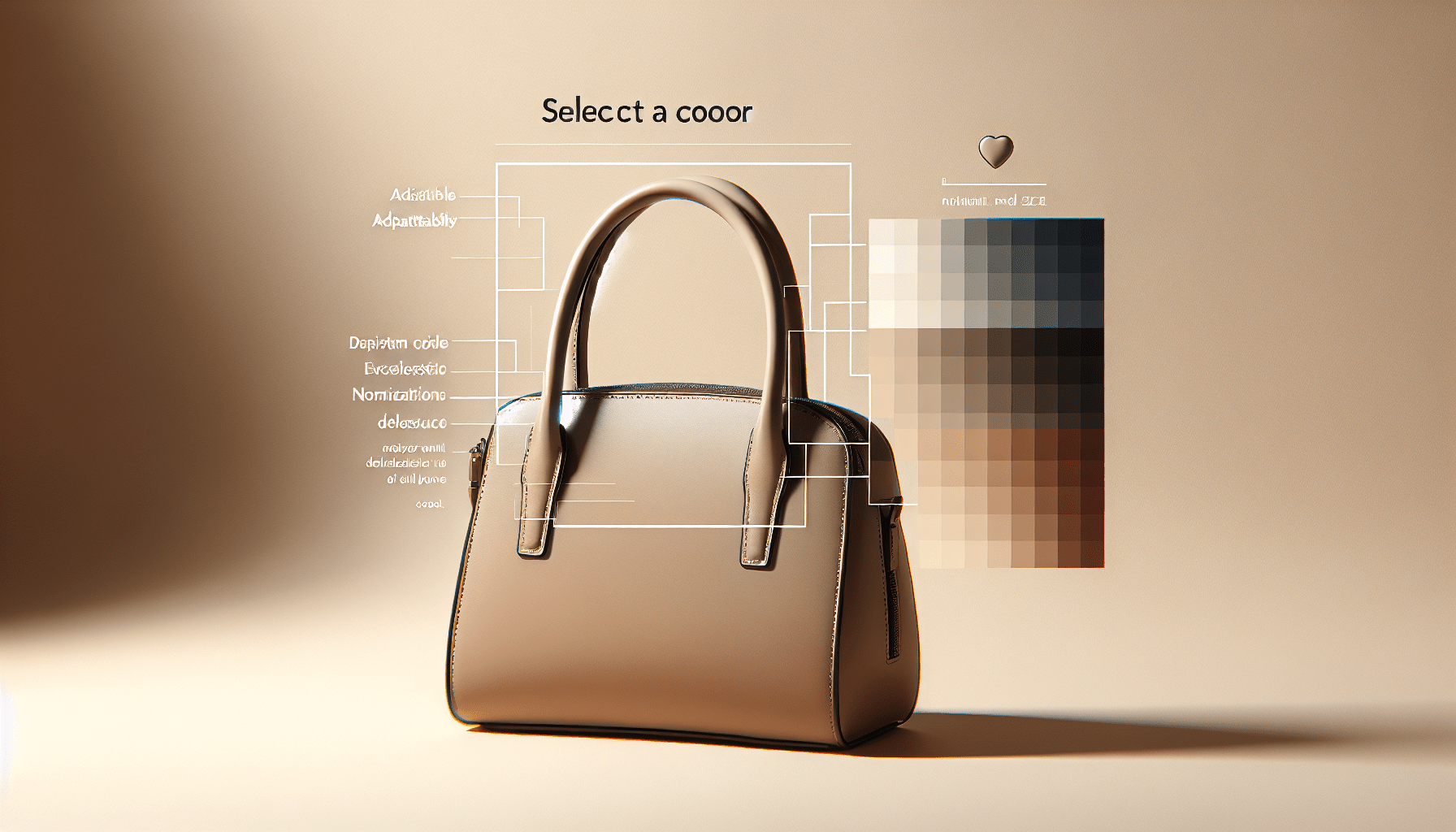How To Fix A Purse Strap
You have been happily using your favorite purse for years, but suddenly, disaster strikes: the strap breaks. Don’t panic! In this article, you will discover a simple and effective method to fix a purse strap, allowing you to continue using your beloved accessory in no time. Whether you’re a seasoned DIY enthusiast or a complete novice when it comes to repairs, this step-by-step guide will provide you with the necessary instructions to make your purse as good as new. Say goodbye to the days of being without your go-to accessory and hello to a quick and affordable solution to fix your purse strap.
Inspecting the Damage
When your purse strap is broken, it’s important to inspect the damage before attempting any repairs. Look closely at the strap to determine the issue. Is it snapped, torn, or simply loose? By identifying the problem, you can then move on to finding the appropriate solution.
Determining the Issue
Once you have inspected the damage, it’s time to determine the exact issue. If the strap is snapped, you will need to fix it by reattaching or replacing it. In the case of a torn strap, you will need to mend it to prevent further damage. For loose straps, you will need to tighten or adjust them accordingly. Understanding the specific issue will help guide you towards the right repair method.
Assessing the Material
Before you begin any repairs, it’s essential to assess the material of your purse strap. Different materials may require different tools or techniques. Common purse strap materials include leather, fabric, nylon, and metal. Consider the material and its durability to ensure you choose the most suitable repair method. This will help prevent further damage and increase the longevity of your strap.
Identifying Critical Areas
While inspecting the damage, it’s important to identify any critical areas that need immediate attention. These may include strap attachments that are weak or on the verge of breaking. By addressing these critical areas early on, you can prevent further damage and potentially save your purse strap from complete failure. Pay close attention to any signs of wear and tear, including fraying or unraveling threads.
Repairing a Broken Strap
Gathering the Necessary Tools
To repair a broken purse strap, gather the necessary tools first. Depending on the material and type of break, you may need items such as a needle and thread, leather glue, replacement strap, buckle, or rivets. Having all the required tools on hand will streamline the repair process and ensure you have everything you need to fix your broken strap.
Fixing a Snapped Strap
If your purse strap has snapped, you can reattach it by sewing or gluing it back together. For fabric or nylon straps, use a needle and thread to carefully stitch the broken ends. Make sure to use a strong, durable thread and reinforce the stitching for added strength. If you have a leather strap, apply leather glue to the broken ends and press them firmly together. Allow the glue to dry completely before using the strap again.
Mending a Torn Strap
When dealing with a torn strap, mend it promptly to prevent further damage. For fabric or nylon straps, use a needle and thread to sew the tear together. Make sure to use small, even stitches and reinforce the area with extra stitching. Leather straps can be repaired using leather adhesive. Apply the adhesive to both sides of the tear and press them firmly together. Allow the adhesive to dry completely before using the strap.
Replacing a Damaged Strap
Basic Strap Replacement
In some cases, a damaged strap may be beyond repair. If this is the case, it’s time to consider replacing the strap altogether. To replace a damaged strap, first, remove the old strap by detaching it from the purse. Then, choose a new strap that matches the style and material of your purse. Attach the new strap using the same method as the original strap, whether it’s sewing, riveting, or using a buckle and connectors.
Choosing a New Strap
When selecting a new strap, consider the material, length, and width that will best suit your purse. Leather straps offer durability and a classic look, while fabric or nylon straps provide versatility and comfort. Pay attention to the hardware of the strap, such as connectors or buckles, to ensure they match your purse’s design. Take measurements to ensure the new strap is the appropriate length and width for your purse.
Attaching a New Strap
To attach a new strap, refer to the attachment method used for the original strap. If it was sewn, use a needle and thread to securely sew the strap onto the purse. For straps that use connectors or buckles, follow the manufacturer’s instructions on how to properly attach them. Double-check the attachment to ensure it is secure and sturdy, as it will bear the weight of your purse.
Strengthening Weak Points
Reinforcing Strap Attachments
If you’ve noticed weak points in the strap attachments, it’s crucial to reinforce them to prevent further damage. For sewn straps, use additional stitches around the attachment area for added strength. If your purse has metal fittings or rivets, consider replacing them with stronger versions. By reinforcing the strap attachments, you can ensure that your purse will withstand regular use without compromising its integrity.
Add Padding or Support
To strengthen weak areas or provide extra support, consider adding padding to your purse strap. This can be achieved by cutting a strip of foam or sponge and inserting it inside the strap. Make sure to distribute the padding evenly to avoid creating lumps or bulges. Padding can help reduce strain on the strap and increase its longevity, especially for heavier purses or those carrying heavier items.
Using Stitching Techniques
Stitching techniques, such as double stitching or cross-stitching, can significantly enhance the strength of your strap. If you feel that the original stitching is weak or prone to unraveling, reinforce it by stitching over it with a stronger thread. Double stitching involves sewing two rows of parallel stitches closely together, while cross-stitching requires intersecting diagonal stitches. These techniques increase the durability of your strap and provide added security.
Reviving a Loose Strap
Re-Tightening Adjustable Straps
If you have a purse with adjustable straps that have become loose over time, you can easily re-tighten them. Check for any adjustable buckles or sliders on the strap and locate the loose section. Pull the strap through the buckle or slider to tighten it. Test the strap to ensure it is securely tightened, and make any necessary readjustments. This simple fix will restore the proper length and tension to your strap.
Dealing with Stretched Straps
Stretched straps can be a common issue with regular use. To fix a stretched strap, start by soaking it in warm water for a few minutes. Remove the strap from the water and squeeze out the excess moisture. Place the wet strap in direct sunlight or use a hairdryer on low heat to dry it. As the strap dries, it will contract and regain some of its original elasticity. Repeat this process if necessary until the strap regains its desired tension.
Adding Extra Holes for Buckles
If you have a buckle strap and need to adjust it further but find that it lacks enough holes, you can easily add extra holes yourself. Use a leather punch or a sharp object, such as a nail or awl, to puncture a small hole where needed. Make sure the hole is cleanly cut to avoid any further damage to the strap. This allows you to fine-tune the length and fit of your strap for optimal comfort.
Dealing with Twisted Straps
Untwisting a Single Strap
If you’ve encountered a twisted strap, it’s important to untwist it properly to prevent any strain or damage. Start by identifying the twists and locate the end that needs to be on the inside of the strap. Hold onto the correct end and carefully rotate the twisted section in the opposite direction until the strap is straightened. Be gentle to avoid putting too much stress on the strap and causing any unnecessary strain.
Fixing Entangled Double Straps
When dealing with entangled double straps, take your time and be patient. Separate the straps as much as possible and identify the twisted sections. Slowly untangle the straps by carefully pulling them apart. If necessary, use your fingers or a small tool to help separate the tangled sections. Once the straps are fully untangled, readjust them to their proper positions. Avoid twisting the straps again when using your purse to prevent future entanglement.
Preventing Future Twists
To prevent straps from twisting in the future, be mindful of how you store your purse. When not in use, lay the purse flat or hang it on a hook rather than tossing it into a pile. This will help keep the straps straight and reduce the likelihood of them becoming entangled. Additionally, avoid carrying bulky or unevenly distributed items in your purse, as this can cause the straps to twist and strain.
Repairing Decorative Straps
Repairing Embellishments
If your purse strap has decorative embellishments, such as beads or sequins, and they become loose or fall off, you can repair them easily. Depending on the type of embellishment and the strap material, you can use super glue or specialty fabric glue to reattach them. Apply a small amount of glue to the back of the embellishment and press it firmly onto the strap. Allow the glue to dry completely before using the strap.
Fixing Studs or Grommets
For straps with studs or grommets that have fallen out or become loose, use pliers to secure or replace them. Gently bend the prongs of the stud or grommet to ensure a tight fit. If the stud or grommet needs to be replaced, carefully remove the old one and insert the new one in its place. Make sure to secure it firmly to prevent it from coming loose again in the future.
Addressing Fraying or Worn Designs
If you notice fraying or worn designs on your strap, it’s essential to address them promptly to prevent further damage. For fabric or nylon straps, apply fabric glue or fray stopper along the fraying edges to prevent them from unraveling. This will help prolong the lifespan of your strap and maintain its appearance. If your strap has a worn design, consider using fabric markers or paints to touch up the worn areas and restore its original look.
Adjusting Strap Length
Shortening a Strap
If you find that your purse strap is too long and needs to be shortened, you can easily adjust its length. Determine the desired length and locate the adjustable buckles or sliders on the strap. Slide the strap through the buckle or slider, pulling it through until you reach the desired length. Secure the excess strap by folding it over and stitching it in place or using a rubber band. Remember to test the strap length to ensure it is comfortable and functional.
Lengthening a Strap
In some cases, you may need to lengthen a strap to achieve the desired fit. If your strap has extra material on the end, you can use it to increase the length. Detach the strap from the purse and add an extension piece, such as a fabric strip or chain, to the end of the strap. Sew or attach the extension piece securely, making sure it is evenly aligned with the original strap. Reattach the lengthened strap to the purse, and adjust the extension piece to achieve the desired length.
Modifying Convertible Straps
If you have a convertible strap that can be worn as a crossbody or shoulder strap, you may need to modify its length to accommodate different styles. Follow the instructions provided by the manufacturer to adjust the strap length accordingly. Many convertible straps have adjustable buckles or sliders that allow you to quickly change the length to your preference. Experiment with different lengths to find the most comfortable and versatile fit for your needs.
Maintaining Leather Straps
Cleaning and Conditioning
To maintain the appearance of your leather purse strap, regularly clean and condition it. Start by wiping away any dirt or surface debris with a soft, dry cloth. For deeper cleaning, use a mild leather cleaner or soap and water. Gently scrub the strap with a soft brush or cloth, then rinse with clean water and pat dry. Once the strap is dry, apply a leather conditioner to moisturize and protect the leather from cracking or drying out.
Treating Cracks or Scratches
If your leather strap develops cracks or scratches, it’s important to treat them promptly to prevent further damage. For minor cracks, use a leather conditioner or moisturizer to hydrate the leather and reduce the appearance of the cracks. Apply the conditioner by massaging it into the affected areas with a soft cloth. Scratches can be treated by gently rubbing a matching leather dye or polish onto the scratched area until it blends in with the surrounding leather.
Avoiding Common Mistakes
When maintaining leather straps, there are a few common mistakes to avoid. Firstly, never use harsh chemicals or abrasive cleaners on leather, as they can cause damage. Avoid exposing your leather strap to excessive moisture or heat, as both can lead to drying and cracking. Additionally, refrain from leaving your leather strap in direct sunlight for prolonged periods, as this can fade the color and damage the leather. By avoiding these mistakes, you can effectively maintain your leather strap’s quality and appearance.
Preventing Future Damage
Proper Purse Storage
To prevent future damage to your purse strap, it’s crucial to store your purse properly when not in use. Avoid leaving your purse on the floor or in damp areas that can potentially weaken the strap material. Instead, store your purse in a clean, dry place, such as a dust bag or on a shelf. This will help protect the strap from unnecessary wear and tear and minimize the risk of damage.
Using Protective Covers
To further protect your purse strap, consider using protective covers or sleeves specifically designed for purse storage. These covers can provide an extra layer of protection against dust, moisture, and accidental scratches. Choose covers made from breathable materials that allow air circulation to prevent mold or mildew. Utilizing protective covers will help preserve the quality of your purse strap and extend its lifespan.
Regular Inspection and Maintenance
Lastly, make it a habit to regularly inspect and maintain your purse strap. By keeping an eye out for any signs of wear and tear, you can address minor issues before they escalate into major problems. Clean and condition your strap periodically, following the appropriate methods for the material. Regularly check strap attachments, stitching, and any decorative elements for signs of loosening or damage. By staying proactive, you can prevent future damage and keep your purse strap in excellent condition.
In conclusion, with the right tools and techniques, you can easily repair a broken purse strap, replace a damaged strap, strengthen weak points, revive a loose strap, deal with twisted straps, repair decorative elements, adjust strap length, maintain leather straps, and prevent future damage. By understanding how to inspect the damage, determine the issue, assess the material, and identify critical areas, you are equipped to tackle any common purse strap problems. Remember to always approach these repairs with care and attention to detail to ensure the longevity and durability of your purse strap. Happy fixing!



